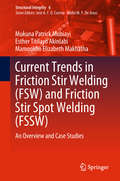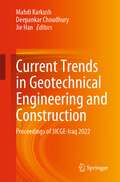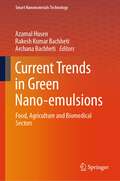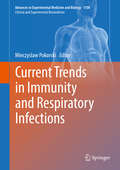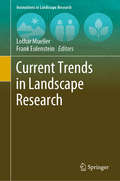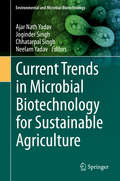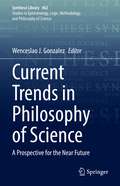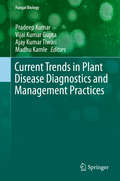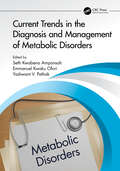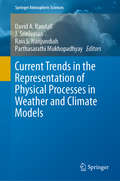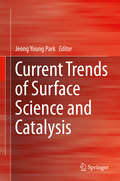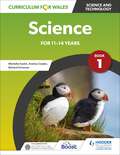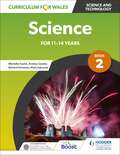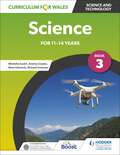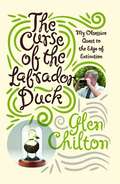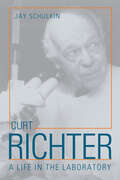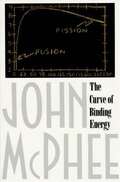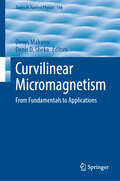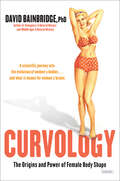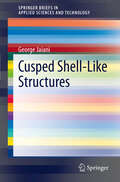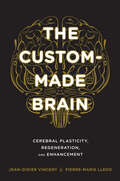- Table View
- List View
Current Trends in Fisheries Biotechnology
by Bijay Kumar BeheraThis book discusses information on recent trends in fisheries biotechnology. It addresses various aspects, such as metagenomics, proteomics, surrogacy, and nano-biosensor applications in fisheries and aquaculture. This is a sunrise sector and provides nutritional security to millions of people globally. Recent developments in biotechnology, such as genomics, proteomics, bioremediation, and nanotechnology, are highly useful for the sustainable development of fisheries and aquaculture. Furthermore, mitochondrial markers, surrogacy, and epigenetics reprogramming have high potential for fisheries and aquaculture advancements. Aquatic ecosystem health surveillance is also very essential for the conservation and management of fisheries biodiversity in natural ecosystems and has also been covered in the book. This book is suitable for undergraduate and graduate students and researchers in fisheries science. It will also be helpful for various written examinations for scientist and assistant professor aspirants in this field, officials of government developmental departments, and allied agricultural sciences. Progressive fish farmers, entrepreneurs, aquaculturists, and individuals involved in the aquaculture industry will find this book valuable.
Current Trends in Friction Stir Welding: An Overview And Case Studies (Structural Integrity Ser. #6)
by Mamookho Elizabeth Makhatha Esther Titilayo Akinlabi Mukuna Patrick MubiayiThis book provides an overview of friction stir welding and friction stir spot welding with a focus on aluminium to aluminium and aluminium to copper. It also discusses experimental results for friction stir spot welding between aluminium and copper, offering a good foundation for researchers wishing to conduct more investigations on FSSW Al/Cu. Presenting full methodologies for manufacturing and case studies on FSSW Al/Cu, which can be duplicated and used for industrial purposes, it also provides a starting point for researchers and experts in the field to investigate the FSSW process in detail. A variant of the friction stir welding process (FSW), friction stir spot welding (FSSW) is a relatively new joining technique and has been used in a variety of sectors, such as the automotive and aerospace industries. The book describes the microstructural evolution, chemical and mechanical properties of FSW and FSSW, including a number of case studies.
Current Trends in Geotechnical Engineering and Construction: Proceedings of 3ICGE-Iraq 2022
by Mahdi Karkush Deepankar Choudhury Jie HanThis book contains selected articles from the third International Conference on Geotechnical Engineering-Iraq 2022 (3ICGE-2022) held on May 29–31, 2022, at the University of Baghdad/Baghdad/Iraq. This proceeding discusses the latest research and studies in geotechnical engineering and all related topics in different fields such as civil engineering, environmental engineering, and architectural engineering. This book gives participants from both academics and industry a great chance to learn about recent developments in Geotechnical engineering fields.
Current Trends in Green Nano-emulsions: Food, Agriculture and Biomedical Sectors (Smart Nanomaterials Technology)
by Azamal Husen Rakesh Kumar Bachheti Archana BachhetiThis book gives a complete overview of current developments on the green synthesis and extraction of nano-emulsions for numerous uses in food, agriculture, biomedical, and cosmetics sectors. In the food and agriculture section, the book demonstrates the use of nano-emulsions to deliver nutraceuticals, coloring, and flavoring agents, in the development of biodegradable coating, improving the quality of packing films and enhancing the shelf life and nutritional value of foods. It also shows that nano-emulsions are very good for pesticides formulation where it enhances the solubility of poorly water-soluble pesticides, resulting in increased pesticide bioactivity compared to conventional pesticides. In the biomedicine applications section, the chapters show that nano-emulsion can dissolve hydrophobic drugs and is used as a drug delivery system for many cancers treatment such as lung cancer, breast cancer, prostate cancer, liver, and gastric cancer. Also, nano-emulsions are an excellent candidate for encapsulating drugs or imaging probes for targeted delivery and immunotherapy. This book caters to scientists, researchers, and students interested in nanotechnology, nanomedicine, environmental science, plant science, agriculture, chemistry, biotechnology, pharmacognosy, pharmaceuticals, industrial chemistry, and many other interdisciplinary subjects.
Current Trends in Immunity and Respiratory Infections (Advances in Experimental Medicine and Biology #1108)
by Mieczyslaw PokorskiThe purpose of this book is to disseminate and deliberate on the latest knowledge concerning immunity and its role in protection and fight against microorganism invasion. The articles tackle both humoral and cellular immunity, and their interconnectivity. The former involves B cells that recognize invading pathogens and create the antibody-mediated response, which when memorized provides future immunity. The latter involves mostly T cells, exemplified by cytotoxic or killer cell destroying the pathogens, or helper cells stimulating B cells to produce antibodies to bind and neutralize the pathogens. T cells act through release of cytokines, interleukins, and other bioactive mediators. Neutrophils play a key role in innate immunity against bacterial infections. The process of NETosis is a recently unraveled sophisticated defense mechanism, consisting of the formation of neutrophil extracellular traps that catch, immobilize, and remove pathogens from the body. Dysfunction of immunity is indisputably conducive to the propensity for infections, particularly respiratory tract infections, as the airways are the first line of defense against invading pathogens. Pathogens can rapidly evolve and adapt to avoid detection by the immune system. The case in point is the influenza virus. The articles report on the epidemiology, diagnostics, serology, complications, and the process of acquired immunity due to vaccination against influenza and influenza-like infections in recent epidemic seasons. The book is a blend of medical research and practice. It is intended for academic scientists, research scholars, clinicians, family doctors, and healthcare professionals.
Current Trends in Landscape Research (Innovations in Landscape Research)
by Lothar Mueller Frank EulensteinThis book presents definitions, key concepts and projects in landscape research and related areas, such as landscape science and landscape ecology, addressing and characterising the international role, status, challenges, future and tools of landscape research in the globalised world of the 21st century. The book brings together views on landscapes from leading international teams and emerging authors from different scientific disciplines and regions of the globe. It describes approaches for achieving sustainability and for handling the multifunctionality of landscapes and includes international case studies demonstrating the great potential of landscape research to provide partial sustainable solutions while developing cultural landscapes and protecting semi-natural landscapes. It is intended for scientists from various disciplines as well as informed readers dealing with landscape policies, planning, evolvement, management, stewardship and conservation.
Current Trends in Microbial Biotechnology for Sustainable Agriculture (Environmental and Microbial Biotechnology)
by Ajar Nath Yadav Joginder Singh Chhatarpal Singh Neelam YadavMicrobial biotechnology is an emerging field with applications in a broad range of sectors involving food security, human nutrition, plant protection and overall basic research in the agricultural sciences. The environment has been sustaining the burden of mankind from time immemorial, and our indiscriminate use of its resources has led to the degradation of the climate, loss of soil fertility, and the need for sustainable strategies. The major focus in the coming decades will be on achieving a green and clean environment by utilizing soil and plant-associated beneficial microbial communities. Plant-microbe interactions include the association of microbes with plant systems: epiphytic, endophytic and rhizospheric. The microbes associated with plant ecosystems play an important role in plant growth, development, and soil health. Moreover, soil and plant microbiomes help to promote plant growth, either directly or indirectly by means of plant growth-promoting mechanisms, e.g. the release of plant growth regulators; solubilization of phosphorus, potassium and zinc; biological nitrogen fixation; or by producing siderophores, ammonia, HCN and other secondary metabolites. These beneficial microbial communities represent a novel and promising solution for agro-environmental sustainability by providing biofertilizers, bioprotectants, and biostimulants, in addition to mitigating various types of abiotic stress in plants. This book focuses on plant-microbe interactions; the biodiversity of soil and plant microbiomes; and their role in plant growth and soil health. Accordingly, it will be immensely useful to readers working in the biological sciences, especially microbiologists, biochemists and microbial biotechnologists.
Current Trends in Mineral-Based Products and Utilization of Wastes: Prospects and Challenges of Mineral Based Products and Utilization of Wastes for the ‘Make in India’ Initiative, Nagpur November 10–11, 2022 (Springer Proceedings in Earth and Environmental Sciences)
by Kirtikumar Randive Ashok Kumar Nandi Pradeep Kumar Jain Sanjeevani JawadandMinerals are essential commodities for the growth of mankind, and all the progress of humanity owes unequivocally to minerals. However, winning minerals through mining has always been cursed, and mankind has paid a heavy price for mining in the form of great loss of flora and fauna and unprecedented impact on the environment. Notwithstanding any arguments either in favor or against, one cannot deny that for the progression, advancement, and security of nations mining is indispensable, compulsory, and unavoidable trade. It is in the best interest of every stakeholder; a sustainable approach to mining must be adopted. Sustainability has many dimensions, two most important being: the optimum utilization of mined-out materials and creating value-added products from the mining wastes. Taking a cue from this, an international seminar was organized on “Prospects and Challenges of Mineral Based Products and Utilization of Wastes for the ‘Make in India’ Initiative” at Hotel Radisson Blu from 10–12 November 2022. The conference was attended by about 120 delegates from all over India. This book is a compilation of selected papers presented during the conference, broadly divided into the following groups: (a) rare earth elements, (b) ferrous minerals, (c) non-ferrous minerals, (d) industrial minerals, (e) waste utilization and valorization and (f) other significant contributions. Written by experts and edited by academicians and technocrats, this book promises to be a valuable and essential reading for professionals, researchers, as well as students.
Current Trends in Philosophy of Science: A Prospective for the Near Future (Synthese Library #462)
by Wenceslao J. GonzalezThis book seeks to provide new perspectives, to broaden the field of philosophy of science, or to renew themes that have had a great impact on the profession. Thus, after an initial chapter to situate the current trends in philosophy of science and the prospective of the near future, it offers contributions in five thematic blocks: I) Philosophy of Medicine and Climate Change; II) Philosophy of Artificial Intelligence and the Internet; III) New Analyses of Probability and the Use of Mathematics in Practice; IV) Scientific Progress Revisited; and V) Scientific Realism and the Instrumentalist Alternative. Within this framework, the volume addresses such relevant issues as the methodological validity of medical evidence or decision making in situations of uncertainty; recent advances in Artificial Intelligence and the future of the Internet; current forms of empirically based methodological pluralism and new ways of understanding mathematics with scientific practice; and the revision of the approaches to scientific progress based on the experiences accumulated in recent decades.
Current Trends in Plant Disease Diagnostics and Management Practices (Fungal Biology #0)
by Vijai Kumar Gupta Pradeep Kumar Ajay Kumar Tiwari Madhu KamlePlant diseases play an important role on our daily lives. Most of plant diseases are visible and are caused by biotic and/or abiotic factors. Symptoms are usually the results of a morphological change, alteration or damage to plant tissue and/or cells due to an interference of the plant's metabolism. All basic structures of vascular plants are subject to attack by pathogens. The failure in accurate disease diagnosis and management may lead to huge losses in plant production and related commodities, which causes nutritional food scarcity. Typically, the appearance of a biotic symptom will indicate the relatively late stage of an infection and/or colonization of a pathogen. Expert detection, accurate diagnosis, and timely management play a significant role in keeping plants free from pathogens. In this book expert scholars share their research knowledge and key literature which are vital toward the diagnosis of plant diseases across the globe, addressing traditional plant pathology techniques, as well as advanced molecular diagnostic approach.
Current Trends in the Diagnosis and Management of Metabolic Disorders
by Seth Kwabena AmponsahEmmanuel Kwaku OforiYashwant V. PathakThis volume provides an overview of the biochemical basis of metabolic diseases and molecular basis of chemical pathologies. Metabolic disorders occur when metabolic processes in the body are disrupted. They contribute a significant burden to human health globally. They can be congenital or acquired, for example, diabetes mellitus, obesity, metabolic syndrome, osteoporosis, osteopenia, mild-moderate hypovitaminosis D, erectile dysfunction, dyslipidemia, and thyroiditis. Metabolic disorders have gained significant importance due to the exponential increase in obesity worldwide. Early diagnosis of metabolic disorders is important in order to employ lifestyle and risk factor modification. Features: An overview of the biochemical basis of metabolic diseases and molecular basis of chemical pathologies Describes recent trends in diagnosis of metabolic disorders Discusses management and treatment of metabolic diseases Allows quick identification and retrieval of material by researchers learning the efficacy, associated dosage and toxicity of each of the classes of compounds Suitable globally for graduate and postgraduate students studying metabolic diseases
Current Trends in the Representation of Physical Processes in Weather and Climate Models (Springer Atmospheric Sciences)
by David A. Randall J. Srinivasan Ravi S. Nanjundiah Parthasarathi MukhopadhyayThis book focuses on the development of physical parameterization over the last 2 to 3 decades and provides a roadmap for its future development. It covers important physical processes: convection, clouds, radiation, land-surface, and the orographic effect. The improvement of numerical models for predicting weather and climate at a variety of places and times has progressed globally. However, there are still several challenging areas, which need to be addressed with a better understanding of physical processes based on observations, and to subsequently be taken into account by means of improved parameterization. And this is all the more important since models are increasingly being used at higher horizontal and vertical resolutions. Encouraging debate on the cloud-resolving approach or the hybrid approach with parameterized convection and grid-scale cloud microphysics and its impact on models’ intrinsic predictability, the book offers a motivating reference guide for all researchers whose work involves physical parameterization problems and numerical models.
Current Trends of Surface Science and Catalysis
by Jeong Young ParkThis unique book covers the latest surface science studies on model catalysts, including single crystals, non-colloidal nanocatalysts, and nanoparticles in various forms with the control of size, shape and composition. This book addresses the issue of bridging "materials and pressure gaps" and also discusses the important issue of metal-oxide interface and hot electron flows in heterogeneous catalysis. The current development of in-situ surface techniques that is relevant to bridging "pressure gaps" is also highlighted.
Curricula for Sustainability in Higher Education (Management and Industrial Engineering)
by J. Paulo DavimThis books presents the curricula necessary for sustainability in higher education. It shows how the learning process is transforming in order to promote sustainability. It prepares administrators, teachers and students to diffuse the development in the field, showing a curricula based on three interconnected pillars: the environment, the economic and the social aspects. It contains 8 chapters introducing research advances in the field.
Curriculum for Wales: Science for 11-14 years: Pupil Book 1
by Richard Grimmer Michelle Austin Andrea Coates Dr Mark Matthews Dr Simon Broadley David Johnston James LewisInspire a new generation of capable and curious scientists.This book will help build pupils' understanding through clear explanations, practicals and skills-based activities, ensuring that they're ready for the next step in their learning and promoting a sense of cynefin through examples and contexts from all around Wales.- Improve working scientifically skills and prepare students for future lab work with practical skills and suggested activities highlighted throughout- Guide pupils through the trickier maths and literacy skills with key term definitions and worked examples with step-by-step solutions- Support a holistic approach with links between the 'what matters' statements in the Science and Technology Area of Learning and Experience (AoLE)- Boost progress using summaries to recap prior knowledge, alongside 'Check your understanding' questions to embed understanding- Develop pupils' curiosity and interest in science with historical context and examples, including many from across Wales
Curriculum for Wales: Science for 11-14 years: Pupil Book 2
by Richard Grimmer Andrea Coates Michelle Austin Mark EdwardsInspire a new generation of capable and curious scientists.This book will help build pupils' understanding through clear explanations, practicals and skills-based activities, ensuring that they're ready for the next step in their learning and promoting a sense of cynefin through examples and contexts from all around Wales.- Improve working scientifically skills and prepare students for future lab work with practical skills and suggested activities highlighted throughout- Guide pupils through the trickier maths and literacy skills with key term definitions and worked examples with step-by-step solutions- Support a holistic approach with links between the 'what matters' statements in the Science and Technology Area of Learning and Experience (AoLE)- Boost progress using summaries to recap prior knowledge, alongside 'Check your understanding' questions to embed understanding- Develop pupils' curiosity and interest in science with historical context and examples, including many from across Wales
Curriculum for Wales: Science for 11-14 years: Pupil Book 3
by Andrea Coates Michelle Austin Richard Grimmer Mark EdwardsInspire a new generation of capable and curious scientists.This book will help build pupils' understanding through clear explanations, practicals and skills-based activities, ensuring that they're ready for the next step in their learning and promoting a sense of cynefin through examples and contexts from all around Wales.- Improve working scientifically skills and prepare students for future lab work with practical skills and suggested activities highlighted throughout- Guide pupils through the trickier maths and literacy skills with key term definitions and worked examples with step-by-step solutions- Support a holistic approach with links between the 'what matters' statements in the Science and Technology Area of Learning and Experience (AoLE)- Boost progress using summaries to recap prior knowledge, alongside 'Check your understanding' questions to embed understanding- Develop pupils' curiosity and interest in science with historical context and examples, including many from across Wales
The Curse of the Labrador Duck
by Glen ChiltonIn an obsessive 82,000-mile quest for dead birds, how much trouble can one scientist get into? Finally, the world's leading authority on the extinct Labrador Duck, Dr. Glen Chilton, shares the story of his frenzied obsession to reveal the histories behind the mysterious bird -- a saga wherein he sets out to examine the remains of every Labrador Duck, conduct genetic analysis on every Labrador Duck egg, and visit every site where the duck was shot...with many a (mis)adventure along the way. More elusive than the Passenger Pigeon, the Dodo, or the Great Auk and breeding in places so obscure that no certain records exist of its nests, the Labrador Duck succumbed to extinction almost before anyone realized it was in decline. When Chilton began his travels, there were thought to be approximately fifty stuffed specimens, scattered among the museums of Europe and North America. However, as his search progressed, it became clear that some specimens had been lost to war and theft, while others lay hidden in far-flung collections, overseen by secretive curators. After traveling the equivalent of 3.3 times around the world with a series of oddball companions, Chilton finally began to close in on every known specimen...but not before he risked heavy-metal poisoning in Russia, swam naked in a glacier-fed stream, corresponded with a millionaire murderer, and narrowly avoided arrest in New York City. A magnificent blend of travel writing, science, detective work, and mishap, The Curse of the Labrador Duck is the zany adventure of one biologist's obsessive quest to uncover the mysteries of one of the world's most enigmatic birds.
Curt Richter: A Life in the Laboratory
by Jay SchulkinIn the first half of the twentieth century, psychology was a discipline in search of scientific legitimacy. Debates raged over how much of human and animal behavior is instinctive and how much is learned, and how behavior could be quantified accurately. At the Johns Hopkins University's new Phipps Psychiatric Clinic, Curt P. Richter stood aside from these heated theoretical arguments, choosing instead to apply his data-collection methods, innovative measurement techniques, playful sense of exploration, and consummate surgical skill to laboratory examinations of the biological basis of behavior. From identifying the biological clocks that govern behavior and physiology to observing the self-regulation of nutrient levels by the body, the cyclical nature of some mental illnesses, and the causes of hopelessness, Richter's wide-ranging discoveries not only influenced the burgeoning field of psychobiology and paved the way for later researchers but also often had implications for the treatment of patients in the clinic. At the time of his death in 1988, Richter left behind a massive collection of laboratory data. For this book, Jay Schulkin mined six decades of Richter's archived research data, personal documents, and interviews to flesh out an engaging portrait of a "laboratory artisan" in the context of his work.
The Curve of Binding Energy: A Journey into the Awesome and Alarming World of Theodore B. Taylor
by John McPheeThis is a book about nuclear energy both for electric power production and for bombs. In particular, it focuses on the dangers of a single person or small group obtaining the materials (most likely from some part of the nuclear power production system) to produce a bomb. The level of worry about this possibility come mainly from a particular nuclear physicist, Ted Taylor. But the sources for this book range far and wide over both the history and people involved in both nuclear bomb making and nuclear power production.
Curvilinear Micromagnetism: From Fundamentals to Applications (Topics in Applied Physics #146)
by Denys Makarov Denis D. ShekaThis is the first book providing overview of magnetism in curved geometries, highlighting numerous peculiarities emerging from geometrically curved magnetic objects such as curved wires, shells, as well as complex three-dimensional structures. Extending planar two-dimensional structures into the three-dimensional space has become a general trend in multiple disciplines across electronics, photonics, plasmonics and magnetics. This approach provides the means to modify conventional and even launch novel functionalities by tailoring the local curvature of an object. The book covers the theory of curvilinear micromagnetism as well as experimental studies of geometrically curved magnets including both fabrication and characterization. With its coverage of fundamental aspects, together with exploration of numerous applications across magnonics, bio-engineering, soft robotics and shapeable magnetoelectronics, this edited collection is ideal for all scientists in academia and industry seeking an overview and wishing to keep abreast of advances in the novel field of curvilinear micromagnetism. It provides easy but comprehensive access to the field for newcomers, and can be used for graduate-level courses on this subject.
Curvology: The Origins and Power of Female Body Shape
by David BainbridgeAnatomy professor David Bainbridge applies the science of evolutionary biology and psychology to look at women's bodies in our ancestral past, our self-image-obsessed present, and our surgically enhanced future. Few things are as tantalizing as a woman's curves...and yet, humans are the only mammals on earth whose females have curvy bodies. Why? And what does this unique body shape mean for us? In Curvology, researcher David Bainbridge uses his scientific know-how to get to the bottom of this anatomical mystery and to explore the social and psychological consequences of our cultural fixation with curves and fat. Bainbridge brings thorough and clear-headed scientific research to this topic, as well as an admirable understanding of the real-life ramifications of the fascinating statistics and provocative studies he cites. Blending evolutionary biology, cultural observation, and cutting-edge psychology, Bainbridge critically synthesize the science and history of women's body shape, from ancient homonids to the age of the selfie, offering insights into how women's bodies became objects of fascination and raising awareness about what this scrutiny does to our brains. Packed with controversial and compelling findings that drive us to think about the significance of our curves and what they mean for future generations, Curvology offers not just a compelling collection of facts and studies, but an endlessly fascinating take on evolution and its consequences.
Cusped Shell-Like Structures (SpringerBriefs in Applied Sciences and Technology)
by George JaianiThe book is devoted to an up-dated exploratory survey of results concerning elastic cusped shells, plates, and beams and cusped prismatic shell-fluid interaction problems. It contains some up to now non-published results as well. Mathematically the corresponding problems lead to non-classical, in general, boundary value and initial-boundary value problems for governing degenerate elliptic and hyperbolic systems in static and dynamical cases, respectively. Its uses two fundamentally different approaches of investigation: 1) to get results for two-dimensional and one-dimensional problems from results of the corresponding three-dimensional problems and 2) to investigate directly governing degenerate and singular systems of 2D and 1D problems. In both the cases, it is important to study relation of 2D and 1D problems to 3D problems.
The Custom-Made Brain: Cerebral Plasticity, Regeneration, and Enhancement
by Pierre-Marie Lledo Jean-Didier Vincent Laurence GareyTwo leading neuroscientists introduce the concepts of "cerebral plasticity" and the "regenerating brain," describing what we know now about the processes through which the brain constantly reconstructs itself and the potential benefits this knowledge might have in addressing concerns for neurological, cognitive, and emotional health.The authors begin with a survey of the fundamental scientific developments that led to our current understanding of the regenerative mind, elucidating some of the breakthrough neurobiological studies that paved the way for our present understanding of the brain's plasticity and regenerative capabilities. They then discuss the application of these findings to such issues as depression, dyslexia, schizophrenia, and cognitive therapy, incorporating the latest technologies in neuroimaging, optogenetics, and nanotechnology. Their work shows the brain is anything but a static organ, ceasing to grow as human beings become adults. Rather, the brain is dynamic, evolving organically in relation to physical, cultural, historical, and affective stimuli, a plasticity that provides great hope to survivors of trauma and degenerative disorders.
The Custom-Made Brain: Cerebral Plasticity, Regeneration, and Enhancement
by Jean-Didier Vincent Pierre-Marie LledoTwo leading neuroscientists introduce the concepts of "cerebral plasticity" and the "regenerating brain," describing what we know now about the processes through which the brain constantly reconstructs itself and the potential benefits this knowledge could have in addressing concerns for neurological, cognitive, and emotional health.The authors begin with a survey of the fundamental scientific developments that led to our current understanding of the regenerative mind, elucidating the breakthrough neurobiological studies that paved the way for our present understanding of the brain's plasticity and regenerative capabilities. They then discuss the application of these findings to such issues as depression, dyslexia, schizophrenia, and cognitive therapy, incorporating the latest technologies in neuroimaging, optogenetics, and nanotechnology. Their work shows the brain is anything but a static organ, ceasing to grow as human beings become adults. Rather, the brain is dynamic, evolving organically in relation to physical, cultural, historical, and affective stimuli, a plasticity that provides early hope to survivors of trauma and degenerative disorders.

